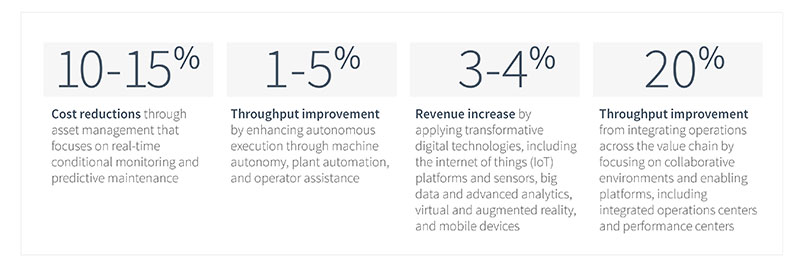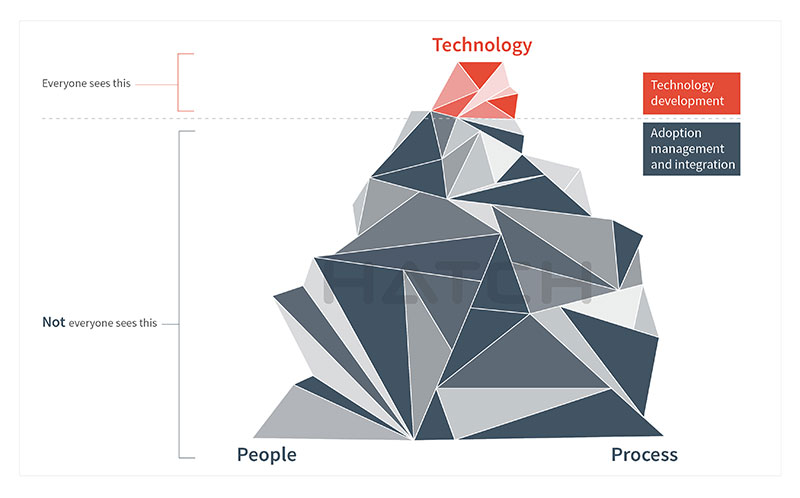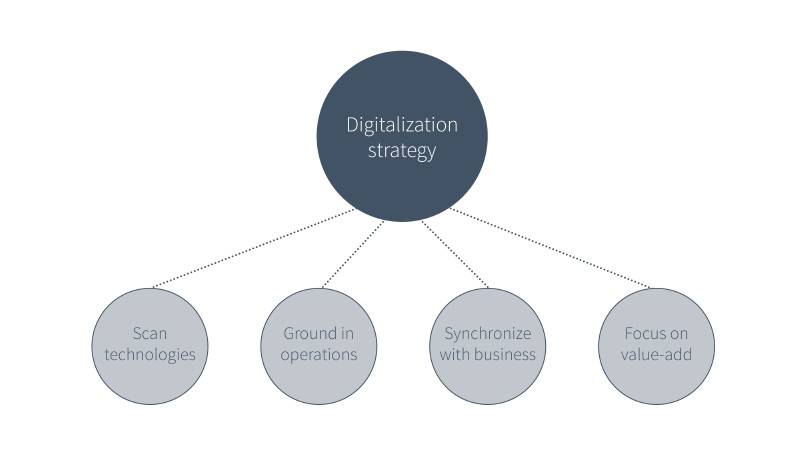Road mapping digital transformation
Many vendors, service providers and consultants are punting their versions of the "mine of the future" or the "digital mine." A recent scan of technology-related solutions in the mining industry identified over 450 solutions from 220 vendors and service providers, spanning software, instrumentation and sensors, services, and consulting. It's no wonder that mining operators often find themselves locked into technologies and solutions based on existing vendor relationships. The only value they can see is what comes from following a particular vendor’s upgrade path and continuing to focus on easy integration with existing technologies.
While this can seemingly be a logical tactic, the value creation is likely to be minimal. Point solutions create pockets of value that tend to resist integration with the neighboring value-chain functions. The resulting shift of operational bottlenecks causes what little value is created to be unsustainable. Ultimately, the risk is a scatter-gun approach that fails to capitalize on the full improvement potential that digitalization offers mining. Some of the lost opportunities could include:

A digital-and-technology road-mapping framework can guide operators in their technology selection and roll-out-plan development. For success, any digital-strategy-development process should be at least operationally engaged. It should incorporate global digitalization trends and speak to the particular organization’s strategic and business objectives.
In digital-transformation efforts with our clients, we’ve found that baking the following elements into a digital strategy can promote the development of a practical, value-adding, and customized journey:
- A global digitalization and technology scan. A keen understanding of how an organization’s peers use digital technologies is always a good starting point to gauge their applicability. But this limits the view. Expanding to adjacent industries gives a more complete picture and allows organizations to think creatively about technology while still remaining grounded by practicality. Ultimately, the goal of this element would be to create benchmarks that are applicable to the particular organization.
- Being grounded in operations. Looking inward to craft a clear operational view of challenges, opportunities, and value drivers is key to assessing the opportunity for technology. It's equally important for understanding areas that are perhaps not ready to accept a digital solution.
- Synchronizing strategic and business objectives. Understanding that today’s challenges and opportunities may not speak to tomorrow’s business intent will facilitate the addition of longer-term relevance to the developed transformation strategy.
- Focus on value-add. Developing upfront value measurement mechanisms for objectively assessing digitalization and technology opportunities and initiatives is essential to ensure that the organization is not digitalizing for the sake of digitalizing.
Crystallizing the strategy into specific outputs makes the digital transformation more tangible and avoids strategies that have unclear boundaries and impractical outcomes. Generally, the strategy development will benefit from the direction provided upfront by a mission-and-objective statement. Outcomes resulting from the strategy can include the road map/project roll-out program, CAPEX and benefit estimates, and infrastructure requirements. The high level process generating these outcomes is described below.
The bottom-up consultations that ground program development in operations and global digitalization can meet through an organization's strategic and business objectives. But, this is always guided by the top down input and overall business vision.The resulting initiatives are synthesized into a practical, time-based roadmap by focusing on areas of key value-add for the business. The successful application of this approach hinges on applying it flexibly. Being adaptable through the strategy-development process can help alleviate some of the common road-mapping challenges, including a poorly defined digital vision; complex, existing systems landscapes; uncertainties around benefits modeling; and the lack of availability of benchmarking, reference, and operational data.
Pervasive themes in the technology and digitalization space include integrated operations, automation, autonomy, and asset management. A robust digital-and-technology-road-mapping framework must seek to tailor these themes and underlying concepts with a view to maximizing operational performance for individual organizations. This is at the heart of the validation, filtering, and prioritization steps of the program development process.
However, digital transformation goes beyond the technology inherent in these themes. Digital must be viewed as an enabler to achieve full performance. For this reason, the full technology, people, and process system must be considered in any digitalization program.
While this system has become something of a consultant’s cliché, a more telling view of the need to consider the people and process aspects of digital transformation can be derived from it. The innovation iceberg highlights that the challenge can remain hidden.

Generally, technology is available or can be developed to meet an organization’s needs. Many of the subsequent roll-outs are sunk, as insufficient attention is given to how the technology will be integrated into the existing standard operation-and-operating model, and how support will be generated among the personnel who must utilize the technology. Adoption management and process review must therefore form part of the digital transformation agenda.
In future posts, we’ll further this discussion and close the loop with how we’ve learnt to best organize digital initiatives and projects, rolling these up into practical programmes and customized themes which aim to deliver sustainable value.


